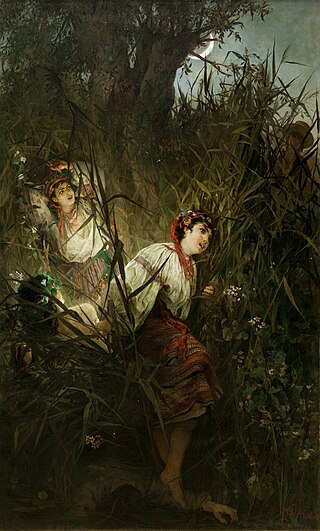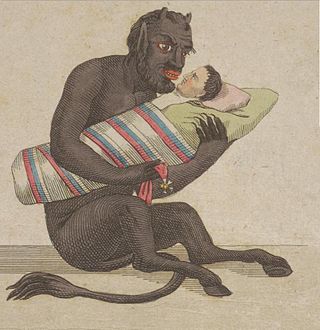
Baba Yaga is an enigmatic or ambiguous character from Slavic folklore who has two opposite roles. In some motifs she is described as a repulsive or ferocious-looking old woman who fries and eats children, while in others she is a nice old woman who helps out the hero. She is often associated with forest wildlife. Her distinctive traits are flying around in a wooden mortar, wielding a pestle, and dwelling deep in the forest in a hut standing on chicken legs.

Dazhbog, alternatively Daždźboh, Dazhboh, Dažbog, Dazhdbog, Dajbog, Daybog, Dabog, Dazibogu, or Dadźbóg, was one of the major gods of Slavic mythology, most likely a solar deity and possibly a cultural hero. He is one of several authentic Slavic gods, mentioned by a number of medieval manuscripts, and one of the few Slavic gods for which evidence of worship can be found in all Slavic tribes.
Devana, Zevana, less often Zievonya is the goddess of wild nature, forests, hunting and the moon worshiped by the Western Slavs. In the sources, she was first mentioned in the 15th century by Jan Długosz, who compared her to the Roman goddess Diana. Dziewanna is also a Polish name for Verbascum, and the etymology of the word is unclear. After strong criticism from Aleksander Brückner, researchers rejected her authenticity, but nowadays it is accepted by an increasing number of researchers. Sometimes, in folk rituals, she performs together with Morana.
Svarog is a Slavic god of fire and blacksmithing, who was once interpreted as a sky god on the basis of an etymology rejected by modern scholarship. He is mentioned in only one source, the Primary Chronicle, which is problematic in interpretation. He is presented there as the Slavic equivalent of the Greek god Hephaestus. The meaning of his name is associated with fire. He is the father of Dazhbog and Svarozhits.
Zorya is a figure in Slavic folklore, a feminine personification of dawn, possibly goddess. Depending on tradition, she may appear as a singular entity, or two or three sisters at once. Although Zorya is etymologically unrelated to the Proto-Indo-European goddess of the dawn *H₂éwsōs, she shares most of her characteristics. She is often depicted as the sister of the Sun, the Moon, and Danica, the Morning Star with which she is sometimes identified. She lives in the Palace of the Sun, opens the gate for him in the morning so that he can set off on a journey through the sky, guards his white horses, she is also described as a virgin. In the Eastern Slavic tradition of zagovory she represents the supreme power that a practitioner appeals to.

Kikimora is a legendary creature, a female house spirit in Slavic mythology. Her role in the house is usually juxtaposed with that of the domovoy. The kikimora can either be a "bad" or a "good" spirit, which will depend on the behavior of the homeowner. In more recent times an image of kikimora as a female swamp spirit had developed.

In the Slavic religious tradition, Domovoy (Russian: Домовой, literally "[the one] of the household"; also spelled Domovoi, Domovoj, and known as Polish: Domowik, Serbian: Домовик, Ukrainian: Домовик and Belarusian: Дамавік is the household spirit of a given kin. They are deified progenitors, that is to say the fountainhead ancestors of the kin. According to the Russian folklorist E. G. Kagarov, the Domovoy is a personification of the supreme Rod in the microcosm of kinship. Sometimes he has a female counterpart, Domania, the goddess of the household, though he is most often a single god. The Domovoy expresses himself as a number of other spirits of the household in its different functions.

Other than the many gods and goddesses of the Slavs, the ancient Slavs believed in and revered many supernatural beings that existed in nature. These supernatural beings in Slavic religion come in various forms, and the same name of any single being can be spelled or transliterated differently according to language and transliteration system.

Likho, liho, lykho is an embodiment of evil fate and misfortune in Slavic mythology, a creature with one eye, often depicted as an old, skinny woman in black or as an evil male goblin of forests. Rather than being included in the major canon of the Slavic belief system, the Likho is traditionally found in fairy tales.

Perkūnas was the common Baltic god of thunder, and the second most important deity in the Baltic pantheon after Dievas. In both Lithuanian and Latvian mythology, he is documented as the god of sky, thunder, lightning, storms, rain, fire, war, law, order, fertility, mountains, and oak trees.
Iriy, Vyrai, Vyriy, or Irij is a mythical place in Slavic mythology where "birds fly for the winter and souls go after death" that is sometimes identified with paradise. Spring is believed to have arrived on Earth from Vyrai.

In Slavic mythology and folklore, the Firebird is a magical and prophetic glowing or burning bird from a faraway land which is both a blessing and a harbinger of doom to its captor.

A chort is an anthropomorphic malign spirit or demon in Slavic folk tradition. Chorts are often depicted identically to Christian devils, with horns, hooves, and a skinny tail. In Slavic mythology, a singular Chort is sometimes identified as a son of the god Chernobog and the goddess Mara. Likewise, in Ukraine mythology, Chorts were originally the priest of Chernobog. In folk Christianity, they are considered lesser minions of Satan.

In Slavic folklore, the rusalka is a female entity, often malicious toward mankind and frequently associated with water, it has counterparts in other parts of Europe, such as the French Melusine and the Germanic Nixie. Folklorists have proposed a variety of origins for the entity, including that they may originally stem from Slavic paganism, where they may have been seen as benevolent spirits. Rusalki appear in a variety of media in modern popular culture, particularly in Slavic language-speaking countries, where they frequently resemble the concept of the mermaid.

European folklore or Western folklore refers to the folklore of the Western world, especially when discussed comparatively. The history of Christendom during the Early Modern period has resulted in a number of traditions that are shared in many European ethnic and regional cultures.

Vesna was a mythological female character associated with youth and springtime in later Slavic mythology, particularly in the South Slavs. Along with her male companion Vesnik, she was associated with rituals conducted in rural areas during springtime.
In Slavic mythology, a vedmak (Belarusian: вядзьмак, вядзьмар; Bulgarian: вещер ; Croatian: vještac; Czech: vědmák; Macedonian: вештер ; Polish: wiedźmak; Russian: ведьмак ; Serbian: вештац; Ukrainian: відьмак ) is a warlock or male witch, the female equivalent (witch) being vedma, but unlike the latter, the vedmak may also possess positive qualities. This role greatly focuses on the Shamanic aspects of Slavic Paganism.

In Slavic paganism there are a variety of female tutelary spirits associated with water. They have been compared to the Greek Nymphs, and they may be either white (beneficent) or black (maleficent). They may be called 'Navki, Rusalki, and Vily.
The Slavic creation myth is a cosmogonic myth in Slavic mythology that explains how the world was created, who created it, and what principles guide it. This myth, in its Christianized form, survived until the nineteenth and twentieth century in various parts of the Slavdom in chronicles or folklore. In the Slavic mythology there are three versions of this myth: the first version is the so-called earth-diver myth, which intertwines two main motifs: the dualistic motif – the cooperation of God and the Devil is required to create the world, and the oceanic motif – the pre-existence water, where the seed of the Earth comes from; the second version speaks about the origin of the universe and the world from the Cosmic Egg and the World Tree; the third one about creation from a dismemberment of a primordial being.













